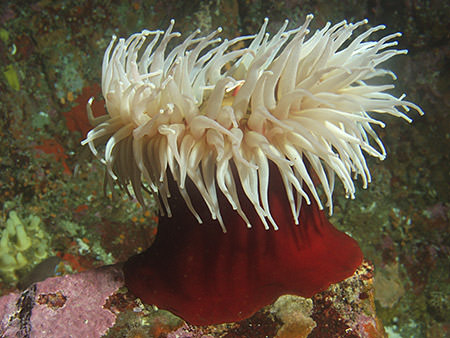Invasive Species
Cordell Bank

Why is it a concern?
A number of non-native species are present in the marine environment near Cordell Bank Sanctuary, but none are known to currently exist in the sanctuary. Nevertheless, it is necessary to understand the pathways by which new species are introduced into the sanctuary, and prioritize which ones pose the greatest threat to Sanctuary resources. Numerous non-native species have been found in the adjacent Greater Farallones National Marine Sanctuary, and a list of non-native species that have a high probability of being found in the Cordell Bank sanctuary has been compiled. The list was obtained by comparing lists of species within and around sanctuary waters to lists of known invaders within California, Bodega Harbor, Tomales Bay, and Elkhorn Slough. The list should therefore be regarded as conservative, including some species that may not yet be within sanctuary waters, but given their geographic proximity, have a high probability of invading in the near future.
There is concern about an invasive tunicate Didemnum sp. that has been observed in nearby coastal areas (Tomales Bay and Bodega Bay, CA) and has the potential to cause great ecological and economic damage. This tunicate is known to spread rapidly, alter benthic habitats, and overgrow sessile organisms such as sponges, anemones, bryozoans, hydroids, macroalgae and native tunicates. Additional sampling is necessary to determine the status of this species. Researchers need to establish baseline information and monitor for new invasions to rapidly evaluate the most feasible and efficient methods of eradication, containment, or management of an introduced species. Such information is critical to minimizing the impact of introduced species on Sanctuary resources and to implementing the protection of species and habitats threatened by introductions. Future surveys and collections of potential invasive species on Cordell Bank may be incorporated into current benthic community transect surveys.
Overview of Research
Research conducted by Sanctuary scientists and partners provides critical information to address existing and emerging resource conservation and management issues. The Overview of Research highlights some, but not necessarily all, of the research activities completed or ongoing at the Sanctuary.
The Cordell Bank National Marine Sanctuary is actively seeking research partners to conduct work connected to Invasive Species as a sentinel issue.
| Project Name | PI and contacts | Links |
|---|---|---|
Cordell Bank Habitat Chracterizatin and Biological Monitoring |
Dale Roberts, Lisa Etherington, Tara Anderson |
http://sanctuarysimon.org/projects/ |
Remotely-operated vehicle surveys |
Danielle Lipski |
Science Needs and Questions
The best available science is used by Sanctuary scientists and managers working to address priority resource conservation and management issues. As priorities change and new issues emerge, each Sanctuary develops new science needs and questions and works with partners to address them.
- See the CBNMS Science Need Assessment related to marine zones for additional information
- Have area closures affected the species composition, distribution, size, and abundance of fishes and invertebrates on Cordell Bank?
- To what extent have fish populations recovered at Cordell Bank?
- What is the genetic structure of fish populations in CBNMS and surrounding areas?
- What are the sources of fish and invertebrate recruits to Cordell Bank?
- What is the contribution of Cordell Bank fishes and invertebrates to populations outside the sanctuary?
Education and Outreach Material
Please refer to the Cordell Bank National Marine Sanctuary website to learn more about education and outreach materials.
References
Anderson, T.J., C. Syms, D.A. Roberts, D.F. Howard. 2009. Multi-scale fish-habitat associations and the use of habitat surrogates to predict the organisation and abundance of deep-water fish assemblages. Journal of Experimental Marine Biology and Ecology 379(1-2): 34-42.
Office of National Marine Sanctuaries. 2008. Cordell Bank National Marine Sanctuary Condition Report 2008. U.S. Department of Commerce, National Oceanic and Atmospheric Administration, Office of National Marine Sanctuaries, Silver Spring, MD. 42pp.
Office of National Marine Sanctuaries. 2010. Cordell Bank Science Needs, Fish Spawning. U.S. Department of Commerce, National Oceanic and Atmospheric Administration, Office of National Marine Sanctuaries, Silver Spring, MD, Accessed: 7/22/2014
Ralston, S. 2003. West coast groundfish: the rockfish problem. In: G. M. Watters (ed.), Proceedings of the NMFS Workshop on Building Environmentally Explicit Stock Assessments, Pacific Fisheries Environmental Laboratory, SWFSC, Pacific Grove, CA.
Young, M.A., P. J. Iampietro, R.G. Kvitek, and C.D. Garza. 2010. Multivariate bathymetry-derived generalized linear model accurately predicts rockfish distribution on Cordell Bank, California, USA. Marine Ecology Progress Series 415:247-261.

